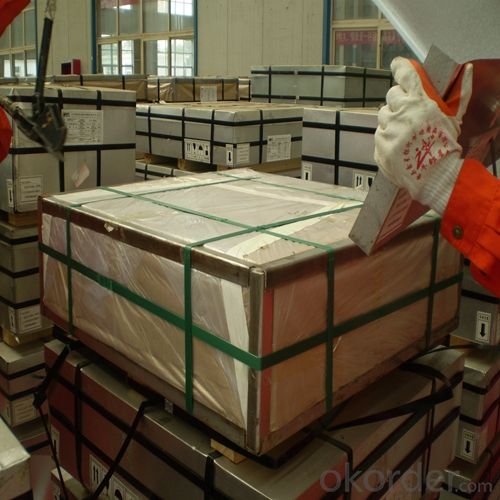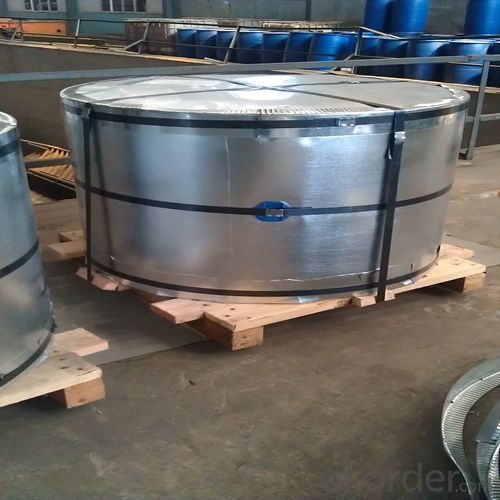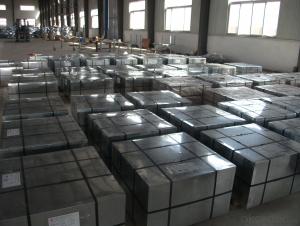ETP for Metal Package of Industrial or Chemical Useage
- Loading Port:
- Shanghai
- Payment Terms:
- TT OR LC
- Min Order Qty:
- 25 m.t.
- Supply Capability:
- 30000 m.t./month
OKorder Service Pledge
OKorder Financial Service
You Might Also Like
Item specifice
1.Structure of ETP for Metal Package of Industrial or Chemical Useage Description
Electrolytic Tinplate undoubtedly enjoys the pride of place as a packaging medium especially for food. It owes its unique position to its "nine layer sandwich structure", each of which contributes to its eminence as a packing material. The steel base of electrolytic tinplate provides the necessary strength and formability for can fabrication. The tin-iron alloy layer provides the bond between the steel and free tin layer. The free tin layer is not only responsible for the attractive bright finish and ease of solderability but is also non-toxic- a factor of vital importance in food packaging!
2.Main Features of the ETP for Metal Package of Industrial or Chemical Useage
Tinplate’s corrosion resistance, light weight and malleability make it ideal for many precision end uses, including food packaging and consumer products. The special properties of tinplate and improved manufacturing technology is allowing for the utilization of tinplate in many new end products.
3.ETP for Metal Package of Industrial or Chemical Useage Images


4.ETP for Metal Package of Industrial or Chemical Useage Specification
Specification of :
Standard: ISO 11949 -1995, GB/T2520-2000,JIS G3303,ASTM A623, BS EN 10202
Material: MR,SPCC
Thickness:0.15mm - 0.50mm
Width: 600mm -1150mm
Temper: T1-T5
Annealing: BA & CA
Coil Inner Diameter: 508mm
Weight: 6-10 tons/coil 1~1.7 tons/sheets bundle
Passivation:311
Oil: DOS
Surface: Finish,bright,stone,matte,silver
5.FAQ of ETP for Metal Package of Industrial or Chemical Useage
- What is tinning and how does it work?
Tinning is the process of thinly coating sheets of wrought iron or steel with tin, and the resulting product is known as tinplate. It is most often used to prevent rust.
- Do you only have prime quality tinplate?
We can supply both prime and second quality tinplate.
- Q:What are the disadvantages of using tinplate in packaging?
- One of the disadvantages of using tinplate in packaging is its susceptibility to corrosion. Tinplate can rust when exposed to moisture and other corrosive elements, which can compromise the integrity of the packaging and potentially contaminate the product. Additionally, tinplate is relatively heavy compared to other packaging materials, which can increase transportation costs and carbon footprint. Lastly, tinplate is not as malleable as other materials, limiting its versatility in certain packaging designs.
- Q:How does tinplate compare to other packaging materials?
- Tinplate offers several advantages compared to other packaging materials. It is highly durable, providing excellent protection for the packaged goods. Tinplate is also resistant to corrosion, ensuring the longevity of the packaging. It is lightweight, making it cost-effective for transportation and storage. Additionally, tinplate is versatile, allowing for various shapes and sizes of packaging, and it provides an attractive appearance, enhancing the visual appeal of the product. Overall, tinplate is a reliable and efficient packaging material that offers numerous benefits in comparison to other alternatives.
- Q:Can tinplate be used for aerosol packaging?
- Yes, tinplate can be used for aerosol packaging.
- Q:What are the common sizes of tinplate sheets?
- The common sizes of tinplate sheets vary, but they generally come in standard dimensions such as 24 x 36 inches, 36 x 48 inches, and 48 x 96 inches.
- Q:Can tinplate packaging be used for beverages?
- Yes, tinplate packaging can be used for beverages. Tinplate is commonly used for beverage cans as it provides a durable and protective barrier against moisture and oxygen, ensuring the quality and shelf life of the drink. Additionally, tinplate is recyclable, making it an environmentally friendly choice for packaging beverages.
- Q:Tin plated tin plated?
- Can electroplate.If the parts need tin plating, it is better not to use tinplate (tin plated steel / strip), galvanized steel plate / ordinary steel plate / strip with or without plating.
- Q:What are the main applications of tinplate in the cosmetics industry?
- Tinplate is primarily used in the cosmetics industry for packaging purposes. It provides a durable and protective barrier that safeguards cosmetic products from external elements, such as light, moisture, and air, thereby extending their shelf life. Additionally, tinplate offers an attractive and visually appealing packaging solution, allowing brands to enhance their product's presentation and create a unique brand identity.
- Q:What are the different tinplate grades available in the market?
- There are several different tinplate grades available in the market, including prime quality, secondary quality, and surplus quality. Prime quality tinplate is the highest grade and is typically used for food packaging and other high-quality applications. Secondary quality tinplate may have minor imperfections but is still suitable for a wide range of applications. Surplus quality tinplate is typically sold at a lower price and may have more noticeable imperfections, making it suitable for less demanding uses.
- Q:How is tinplate coated with polymer films?
- Tinplate is coated with polymer films through a process called extrusion coating or lamination. In extrusion coating, a molten polymer is extruded onto the surface of the tinplate, forming a thin film after cooling. Lamination involves bonding a pre-made polymer film onto the tinplate using heat and pressure. Both methods provide a protective barrier and enhance the corrosion resistance of the tinplate.
- Q:How does tinplate perform in terms of mechanical strength and durability?
- Tinplate is known for its excellent mechanical strength and durability. It is highly resistant to bending, denting, and breaking, making it ideal for various applications where strength is crucial. Additionally, tinplate is highly durable and can withstand harsh environmental conditions, including corrosion and rust. Overall, tinplate is a reliable and long-lasting material in terms of mechanical strength and durability.
1. Manufacturer Overview |
|
|---|---|
| Location | |
| Year Established | |
| Annual Output Value | |
| Main Markets | |
| Company Certifications | |
2. Manufacturer Certificates |
|
|---|---|
| a) Certification Name | |
| Range | |
| Reference | |
| Validity Period | |
3. Manufacturer Capability |
|
|---|---|
| a)Trade Capacity | |
| Nearest Port | |
| Export Percentage | |
| No.of Employees in Trade Department | |
| Language Spoken: | |
| b)Factory Information | |
| Factory Size: | |
| No. of Production Lines | |
| Contract Manufacturing | |
| Product Price Range | |
Send your message to us
ETP for Metal Package of Industrial or Chemical Useage
- Loading Port:
- Shanghai
- Payment Terms:
- TT OR LC
- Min Order Qty:
- 25 m.t.
- Supply Capability:
- 30000 m.t./month
OKorder Service Pledge
OKorder Financial Service
Similar products
New products
Hot products
Related keywords




























